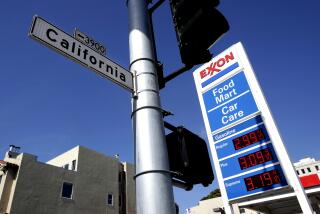Citadel Chairman Faces Test on Valley Federal Deal
- Share via
Less than two months into his new job as chairman of Citadel Holding Corp., Edward L. Kane faces a nagging problem.
At issue is whether Citadel, the Glendale holding company for Fidelity Federal Savings & Loan, should go ahead with its tentative plans to pursue a takeover of sickly Valley Federal Savings & Loan in Van Nuys.
Citadel is struggling with lower profits, which the company blames on the recent increase in interest rates. But some analysts say that Kane has inherited one of the strongest and most efficient S&Ls; in the nation, and that it could sharply improve the profitability of Valley Federal by applying Citadel’s low-overhead techniques there.
Citadel’s “financial characteristics are superb,” said Jonathan Gray, an analyst with the investment firm Sanford C. Bernstein in New York. He said Citadel’s name “is as much a description as an appellation.”
Yet Citadel, with $4.8 billion in assets and 33 branch offices, still has its critics. Other analysts say that even though higher interest rates are troubling most thrifts, Citadel’s management is without a decisive strategy to make the company a standout in years ahead.
“It’s a ‘me-too’ savings and loan,” said Gerald S. Haims of Seidler Amdec Securities in Los Angeles. “They’re just treading water.” He also said Kane, a 51-year-old lawyer who used to work on Wall Street, was elected chairman because “there’s nobody really strong within” Citadel with S&L; management credentials.
Kane and Samuel C. McCarver, Citadel’s chief operating and financial officer, vigorously disputed such claims. They noted that Kane had been vice chairman of Citadel since January, 1987, has been a Citadel director since 1985 and briefly filled in as president in early 1987.
Kane “certainly was the most qualified and certainly a very logical candidate for the position,” McCarver said.
James F. Wilson, an analyst with Sutro & Co. in San Francisco, agreed that the company needs “a larger management crew” because “Kane is not an operator, and has no background in the S&L; business.” He said Citadel is “looking for either a new chief executive or a new No. 2 man, someone to work with McCarver.”
But now that Kane is chairman, he wants to make a decision on Valley Federal. “I will personally try to see if we can’t either consummate something or terminate” the merger plans, he said. “It’s silly to keep going along this way.”
Citadel has talked about the merger for more than two years. Kane likes the match, believing that it would make Citadel “the predominant lender” in the San Fernando Valley residential real estate market.
No deal has yet been struck because, among other things, Valley Federal, with $3.4 billion in assets and 45 branches, had been resisting Citadel’s overtures. Valley Federal did say two weeks ago that it would consider a firm offer, however. But Valley Federal’s worsening condition--it lost $3 million last year--has forced Citadel to take a longer, harder look. New thrift legislation working its way through Congress has also given Citadel pause.
Inherited Problems
Kane also inherits some problems at Citadel. The thrift’s profit fell 3% in 1987 and 15% last year, and it “will be substantially lower” in 1989 because of the recent rise in interest rates, Kane said.
Kane said the interest-rate increases are occurring much faster than Citadel can successfully boost the interest rate that it charges on home mortgages. Most of Citadel’s mortgages have adjustable rates that change with market conditions, but those ARMs are tied to an interest-rate index whose changes lag those of money-market rates, he said. As a result, the difference between Citadel’s interest income and its interest costs is rapidly narrowing, and so is its profit.
In 1988, Citadel’s earnings fell to $24.1 million from $28.2 million in 1987. Last week, Citadel said its first-quarter 1989 profit tumbled 51% from a year earlier, to $3 million from $6.1 million.
Citadel’s return on average assets--a key gauge of profitability because it measures a thrift’s performance relative to the assets at its disposal--was 0.58% last year, well below the 1% ratio that is considered an excellent showing. Citadel has plenty of company, though; the average ROA in California last year was a mere 0.20%, according to Sheshunoff Information Services, a financial research firm in Texas.
Stock Low
Citadel’s stock, now at $36.50 a share on the American Stock Exchange, remains 35% below its level of three years ago. The stock also is 37% below Citadel’s book value per share, or its net worth, which is the amount of Citadel’s assets minus its liabilities.
Stocks trading well below book value in many industries are considered to be bargains. However, these days many S&Ls; trade at discounts to book value because investors are worried about the serious problems throughout the thrift industry.
But analyst Gray said Citadel remains a bargain, particularly if interest rates fall in the next three or four years, which would send Citadel’s profit soaring because of the S&L;’s low-cost structure. Citadel’s stock “looks like a two-seater Mercedes convertible priced like a Ford Taurus with 40,000 miles on it,” Gray said.
Sutro’s Wilson agreed that when interest rates finally turn down, Citadel “will be benefiting more than others” because its overhead costs amounted to a mere 1.16% of its assets at year-end 1988--the second lowest among the 20 West Coast S&Ls; that he follows. Only Golden West Financial, a perennial low-cost operator, had a lower ratio at 1.14%, he said.
Loan Portfolio
Citadel’s loan portfolio is also relatively strong. Its repossessed real estate--indicating Citadel loans that went sour--totaled 0.4% of its total assets at year-end 1988, compared with an average 0.7% for California thrifts and 1.8% nationwide.
Citadel’s “non-performing assets,” which include the repossessions and existing loans 90 days past due, fell to 0.74% of assets at year-end from 1.03% two years earlier. That drop came even as Citadel’s assets jumped 42% in the past two years. “Our savings and loan business, in my judgment, is second to none among our peers,” Kane said.
There is a perception by some analysts that Kane is sharing power with James J. Cotter, a Los Angeles investor with a hand in many companies, including Citadel. Cotter is a former Citadel director and chairman of Craig Corp., whose holdings include an 8.5% stake in Citadel and control of the Stater Bros. grocery chain. Cotter also is a partner of Hecco Ventures, an investment partnership that owns 9% of Citadel and about 10% of Valley Federal. Kane serves as Craig’s president.
Proxy Fight
Cotter left Citadel’s board last year after winning a bitter proxy fight to gain a seat on Valley Federal’s board of directors and has urged Valley Federal’s sale to Citadel or another party.
Wilson said Kane’s election as Citadel’s chairman means “Cotter is in charge” at Citadel.
Cotter did not return telephone calls requesting comment.
Citadel remains a closely held company. About 60% of Citadel’s stock is owned by half a dozen big investors, including Tucson Electric Power, which owns 20%; Hecco and Craig, and the group has “a hand in directing our philosophy,” Kane said. That philosophy calls for Citadel to keep growing with the help of acquisitions--even if the Valley Federal deal falls through.
Recently Citadel has gone shopping but its purchases have been small. Citadel has agreed to buy tiny Rancho Bernardo Savings ($130 million in assets) as a first step into the San Diego market, and has bought several branch offices from other S&Ls.;
Citadel is also considering providing customers with expanded investment and insurance services, and may sell more of its mortgage loans to investors to generate more earnings.
But the Valley Federal matter likely will be Kane’s first big test. “The economics are there, the synergies are there” for a successful merger, he said. The deal will depend on whether Citadel gets there with the right offer.
COMPARING S&L; STOCK PRICES AND BOOK VALUES
Below are the per-share stock prices of various California S&Ls; as a percentage of their book values per share. Book value is the amount of a thrift’s assets less its liabilities, or its net worth. Investors often use the stock-book value ratio to gauge whether the stock is a bargain or overpriced. It’s often thought that a stock trading below its book value falls into the bargain category. But as the chart shows, these days many S&Ls; trade at discounts to book value, in large part because investors are worried about the nationwide S&L; crisis.
Stock Price Book Value Stock Price as % of S&L; as of 3/31 as of 5/5 BookValue Citadel Holding $57.70 $36.50 63% (parent of Fidelity Federal) Valley Federal $18.20 $9.25 51% Glenfed $37.80 $19.25 51% (parent of Glendale Federal) Calfed $55.35 $22.125 40% (parent of California Federal) H.F. Ahmanson $19.30 $19.875 103% (parent of Home Savings)
More to Read
Inside the business of entertainment
The Wide Shot brings you news, analysis and insights on everything from streaming wars to production — and what it all means for the future.
You may occasionally receive promotional content from the Los Angeles Times.











